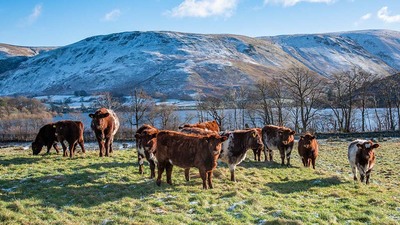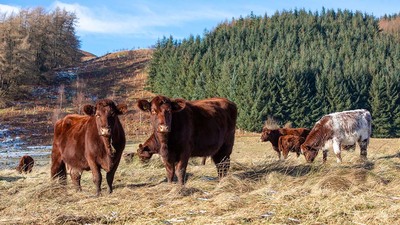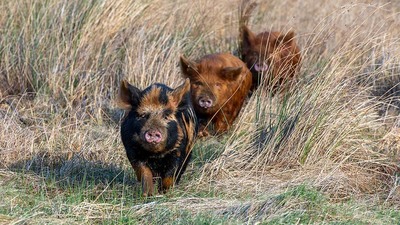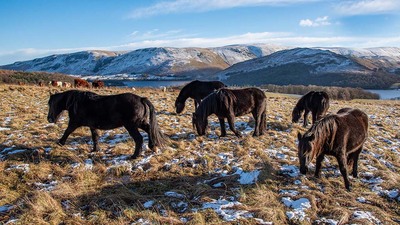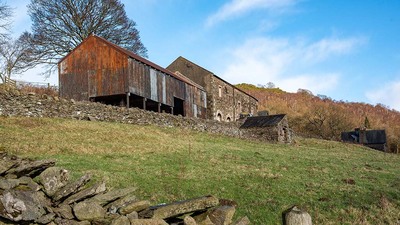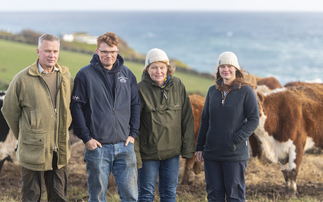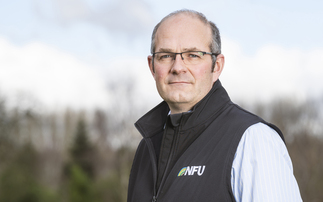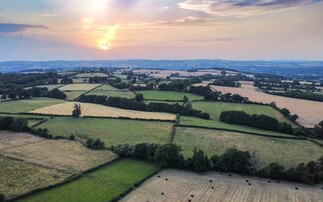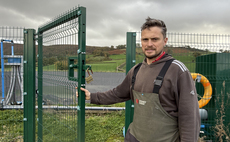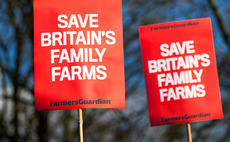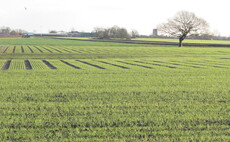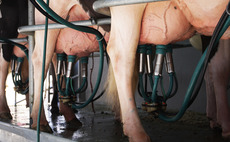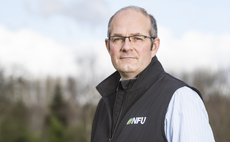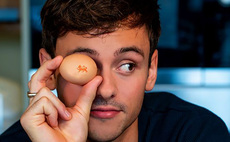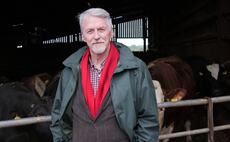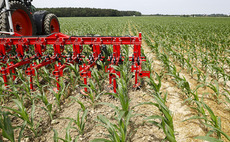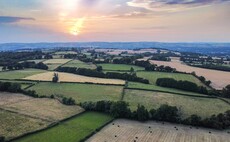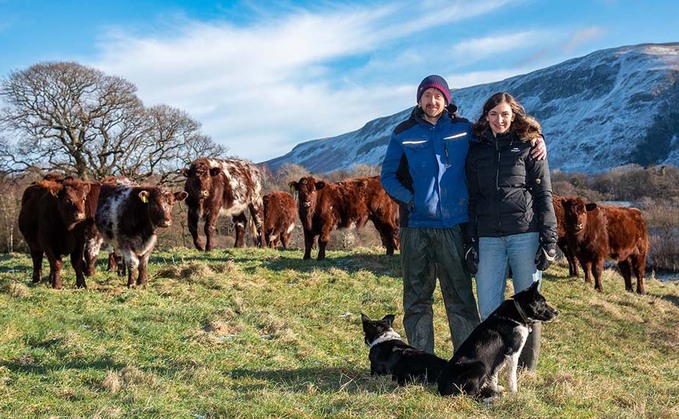
Sam and Claire Beaumont have given the family upland farm a new lease of life. Emily Ashworth finds out about how they found their passion for the environment.
Having finally put their own stamp on their upland farm in the Lake District, Sam and Claire Beaumont have, over the years, tried and tested many methods, but they have now found their niche.
Both met in London through their careers as engineers, but Claire grew up on Gowbarrow Hall farm, which sits peacefully alongside Ullswater lake.
The couple were keen to move out of the city and moving back home to farm presented them with the perfect opportunity.
Claire, 37, says: My granddad, who originally farmed in west Cumbria, bought this in the 1970s.
He farmed until the late 1990s and when he passed away, it was left to my nana and when she passed in 2001, my parents took it on.
Mum had been told to get another career, so for 20 years it had been on annual grazing licenses to mainly sheep farmers until 2017.
Both of us were keen to move out of London - I loved growing up here and wanted it for our children.
We proposed to mum that we come back and start farming.
Traditional upland farming
But it became apparent that for them, it was not going to be economical.
Claire says: We did not have any aspirational plans to make massive changes.
We tried for a few years, but for various reasons we just did not feel happy with how it was going.
Prices at the auction were not good and we were buying feed to get the lambs to grow. We could see how reliant the farm was on inputs.
We were also not happy with the environmental impact the amount of fertiliser was having.
Farming more environmentally
They began to question how they farmed and what sort of changes they could make. And as fate would have it, the right opportunity was about to fall right into their laps.
Farming is in Sams family too his great uncle owned a farm in Derbyshire, which he visited a lot as a child. It was left to Sams dad, and when he went to university, Sams parents took on the farm near Matlock.
After hearing a talk back home, Sam was introduced to the Pasture for Life scheme and the idea of mob grazing.
Sam, 37, says: I used to help them in the summer holidays and absolutely loved it. I always saw myself back on the farm, but then I met Claire and we moved up here. And as they say, the rest is history.
The talk was all about tall grass grazing, mob grazing and moving cows and I thought, I want to do that.
They decided to introduce cows to the farm, both of them keen on showcasing the benefits of integrating livestock.
They chose Shorthorns, a native and hardy breed, but also commercial.
Claire says: There is a market for them - a Pedigree Shorthorn sale and the Morrisons scheme, plus direct sales opportunities.
When we were looking at the options, I have to admit that rewilding did cross our minds, but we still wanted to actually farm and produce food.
The cows are now the main financial and ecological driver.
And since then, they have not looked back. The 155-hectare (385-acre) farm has certainly taken on a different role since their return.
Ecological restoration
They began to work with Primal Meats, a business centred around sustainable food production, established by nearby farmer Caroline Grindrod who also runs Wilderculture, a project that encourages an integrated approach to ecological restoration and food production.
Caroline was looking for a flagship farm to encapsulate what Wilderculture is all about and Gowbarrow was the perfect example.
The land regeneration project is now in full swing, with their lower meadows regenerating to species rich grassland, a rougher area which they call the park is being restored to woodland pasture and they also have the fell land which is heather moorland habitat.
Claire says: We wanted to have the farm running as a natural ecosystem and let nature and biodiversity restore itself, with our support and the addition of livestock as part of that ecosystem."
They have 60ha (150 acres) of woodland too and split the farm into a summer and winter block. From April to November, the lower meadows are mob grazed around an acre at a time depending on the length of the grass and during that period the winter block is left to rest.
The winter block has that whole period to grow; there is a lot of natural tree regeneration and a lot more flowers that we never knew existed coming through. The cattle are there from November to March and it means we can out-winter, which was big factor in how we wanted to run the farm, says Claire.
They also introduced fell ponies, partly from a heritage point of view, but they graze differently from cows as they eat much rougher grasses.
Then came the pigs to introduce some disturbance to the ground. They have free roam of the rough areas and the woodland.
They chose Kunekune pigs, which means fat and round in Mauri and originate from New Zealand. They have a small snout to turf up just enough ground and do not need supplementary feed.
Shorthorn cattle
Currently the heard stands at 50 Shorthorns, but after calving those numbers should increase to about 75.
Calving takes place in the spring and they are currently trialling leaving calves with their mothers longer than they have previously.
Sam says: We are seeing if we can delay weaning, until around two months before the next calf.
It is about optimising growth rates and they can go straight onto good grass then. We see them slip slightly towards the end of winter.
Reducing the amount of hay they make is another avenue they are pursuing, noticing the stress it can put on a field and have begun bale grazing, where they leave bales unwrapped in the field over winter.
They have also recently started supplementing the cattle with seaweed too, after tests showed the herd had low iodine levels.
All cattle are finished on-farm and are put to a Shorthorn bull called Merlot.
He is a traditional Shorthorn bull from a herd in the south west called Stonmour, which is the only herd in the country that has 100 per cent traditional Shorthorn genetics, with no Continental or Canadian bloodlines, says Sam.
Female pigs are sold as breeders and the males are kept for meat. Nearly all the beef is sold directly to customers nationwide, with a waiting list for their beef boxes.
I think it is because it is Pasture For Life certified, with a higher nutrient density and it is better for soil health and biodiversity, says Sam.
Last year they started to sell whole carcasses to a butchers called Roast Mutton based in Kendal, who have the philosophy from fell to fork.
Eating meat
Rob Unwin, the butcher they deal with, is invested in how Sam and Claire rear their animals and Robs father, David, has published many studies on the link between health and well produced meat.
And this is one of Sams main drivers.
Sam says: Part of the motivation for me was the stuff in the media about cutting meat out of your diet. I just knew it was not the right thing, not really it might be for some people, but I feel I sort of have a duty to find an alternative way.
Experimenting
They have just entered into the Higher Stewardship Scheme, having waited to find a scheme that suited their farm, rather than change the way they run their farm to suit a scheme.
They are doing a mix of species rich grassland, woodland pasture restoration and are currently converting to organic, which is, says Sam, a big step.
Although Gowbarrow has seen much change over the years, Claires parents, who are still partners in the farm, have supported them in their transition.
Claire says: Mum loves seeing the biodiversity on the farm and has been doing talks locally.
Dad comes and helps us with the cows too. They are much more engaged in what we are doing now than when we first returned.
And change is still afoot, as they look to convert one of their buildings into an education centre and are keen to host land-based skills and training courses that benefit upland systems, for which they have a Farming in Protected Landscapes grant for.
There are a lot of tourists in this area too; it is an inspiring place, so it makes sense to try and inspire others," says Sam.
They have done what they intended to in terms of reducing their inputs, but they feel their biggest challenge is the prospect of the smaller more local abattoirs closing and they try their best to not be reliant on other businesses, but this part is a vital cog.
Sam Says: If we lose them and that supply chain then we cannot sell our beef and it seems to be getting harder and harder for them. It is something we have no control over."
Looking out over the lake, it really is no wonder Claire felt the call of home. It truly is a picture of serenity and ideal to bring up their children, Beatrix, six, and Ike, two.
But they will not rest on their laurels, with their engineering intuition pushing them both to test the waters.
Claire says: With our backgrounds, we like to experiment or innovate as Sam puts it.
People are scared to try things in farming and fail.
We are very open about what has and has not worked, but we have learnt so much from other people.
